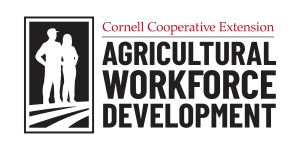by Elizabeth Higgins, Eastern NY Commercial Hort Program, CCE
Frontline farm workers and meat packing workers who were employed sometime between January 27, 2020 and May 11, 2023 are eligible to receive a $600 Farm and Food Workers Relief Program payment from the federal government. Although many workers have received this payment already, there are still eligible workers in New York. Are any of them on your farm? The window of opportunity to apply for these funds is closing and we want to help you help your workers receive this benefit.
The Agricultural Workforce Development Council of New York State is collaborating with PASA (Pennsylvania Sustainable Agriculture Association) to offer three in-person events in New York State at the end of October where workers can sign up for the program in person. They will be:
- Western, NY: October 22 (10-4) and October 23 (9-4) at the Wallington Fire Department, 7863 Ridge Road, Sodus, NY 14551
- Capitol District, NY: October 25 (9-4) at the Washington County Fairgrounds, 392 Old Schuylerville Rd, Greenwich, NY 12834
- Hudson Valley, NY: October 26 (9-4) at the CCE Ulster County office, 232 Plaza Rd, Kingston, NY 12401
Applicants must provide acceptable (1) photo identification and (2) proof of employment as a farm worker or meatpacking worker within the U.S. and its territories during the period between January 27, 2020 and May 11, 2023. Youth (under the age of 18) are eligible for a relief payment. Youth must provide the same documentation as described below.
Acceptable photo identification includes:
- State-issued driver’s license or identification
- Consular- or government-issued identification (foreign or domestic)
- H2A Visa or H2B Visa
- Employer-issued identification
Acceptable proof of employment includes:
- W-2 tax form from 2020, 2021, or 2022
- Pay stub that pre-dates May 11, 2023
- Employment contract
- Letter from an employer, including employee name, occupation, work performed, time period employed, and employer signature
- H2A Visa or H2B Visa
PASA staff will be on-hand to enroll eligible workers who have not yet received their federal payments. At these events, workers will receive a payment card, so it will be beneficial for workers who do not maintain US bank accounts.
You can learn more about the program and confirm eligibility at www.farmworkers.org. If you cannot make an in-person event you can still apply for the program online at that website. You can also check the status of your application if you have already applied.
I have heard from farms who said that their employees applied but did not hear back. According to PASA they have had applications that were missing information but did not have a good contact number to reach the applicant, so they advised contacting them directly as it is possible that the worker is eligible but there is an error in the application. If you have questions about the program, contact PASA at (833) 469-3397 or by email at support@pasafarming.org.


